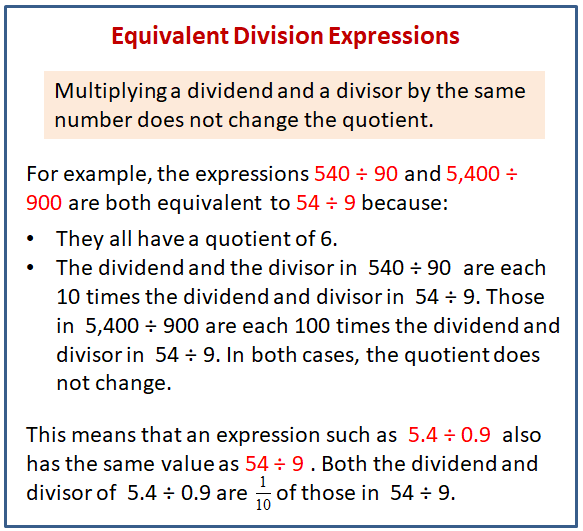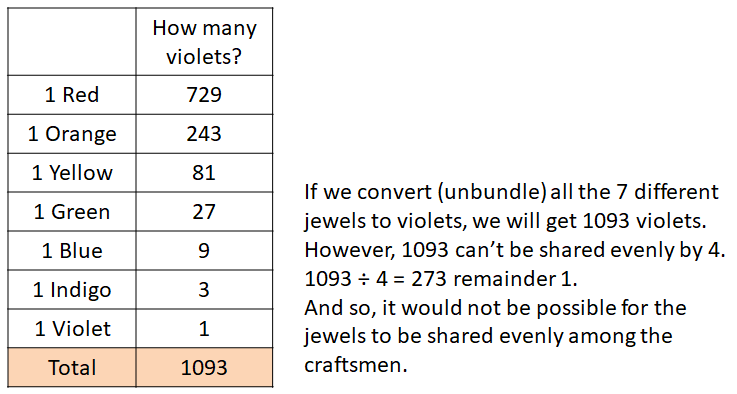Illustrative Mathematics Unit 6.5, Lesson 12: Dividing Decimals by Whole Numbers
Learning Targets:
- I can divide a decimal by a whole number.
- I can explain the division of a decimal by a whole number in terms of equal-sized groups.
- I know how multiplying both the dividend and the divisor by the same factor affects the quotient.
Related Pages
Illustrative Math
Grade 6
Lesson 12: Dividing Decimals by Whole Numbers
Let’s divide decimals by whole numbers.
Illustrative Math Unit 6.5, Lesson 12 (printable worksheets)
Lesson 12 Summary
The following diagram gives an example of equivalent division expressions.

Lesson 12.1 Number Talk: Dividing by 4
Find the quotients mentally.
80 ÷ 4
12 ÷ 4
1.2 ÷ 4
81.2 ÷ 4
Lesson 12.2 Using Diagrams to Represent Division
To find 53.8 ÷ 4 using diagrams, Elena began by representing 53.8.
She placed 1 ten into each group, unbundled the remaining 1 ten into 10 ones, and went on distributing the units.
This diagram shows Elena’s initial placement of the units and the unbundling of 1 ten.
- Complete the diagram by continuing the division process. How would you use the available units to make 4 equal groups?
As the units get placed into groups, show them accordingly and cross out those pieces from the bottom. If you unbundle a unit, draw the resulting pieces. - What value did you find for 53.8 ÷ 4? Be prepared to explain your reasoning.
- Use long division to find 53.8 ÷ 4. Check your answer by multiplying it by the divisor 4.
- Use long division to find 77.4 ÷ 5. If you get stuck, you can draw diagrams or use another method.
Are you ready for more?
A distant, magical land uses jewels for their bartering system. The jewels are valued and ranked in order of their rarity. Each jewel is worth 3 times the jewel immediately below it in the ranking. The ranking is red, orange, yellow, green, blue, indigo, and violet. So a red jewel is worth 3 orange jewels, a green jewel is worth 3 blue jewels, and so on.
A group of 4 craftsmen are paid 1 of each jewel. If they split the jewels evenly amongst themselves, which jewels does each craftsman get?
-
Show Answer
We are assuming that the question means that a total of 7 different jewels are to be shared evenly among the 4 craftsmen.

Lesson 12.3 Dividends and Divisors
Analyze the dividends, divisors, and quotients in the calculations, then answer the questions.
- Complete each sentence. In the calculations above:
- Each dividend is ______ times the dividend to the left of it.
- Each divisor is ______ times the divisor to the left of it.
- Each quotient is _____________________ the quotient to the left of it.
- Suppose we are writing a calculation to the right of 72,000 ÷ 3,000. Which expression has a quotient of 24? Be prepared to explain your reasoning.
a. 72,000 ÷ 30,000
b. 720,000 ÷ 300,000
c. 720,000 ÷ 30,000
d. 720,000 ÷ 3,000 - Suppose we are writing a calculation to the left of 72 ÷ 3. Write an expression that would also give a quotient of 24. Be prepared to explain your reasoning.
- Decide which of the following expressions would have the same value as 250 ÷ 10. Be prepared to share your reasoning.
a. 250 ÷ 0.1
b. 25 ÷ 1
c. 2.5 ÷ 1
d. 2.5 ÷ 0.1
e. 2,500 ÷ 100
f. 0.25 ÷ 0.01
Lesson 12 Practice Problems
- Here is a diagram representing a base-ten number. The large rectangle represents a unit that is 10 times the value of the square. The square represents a unit that is 10 times the value of the small rectangle.
Here is a diagram showing the number being divided into 5 equal groups.
a. If a large rectangle represents 1,000, what division problem did the second diagram show? What is its answer?
b. If a large rectangle represents 100, what division problem did the second diagram show? What is its answer?
c. If a large rectangle represents 10, what division problem did the second diagram show? What is its answer? - a. Explain why all of these expressions have the same value.
4500 ÷ 90
450 ÷ 9
45 ÷ 0.9
4.5 ÷ 0.09
b. What is the common value? - Use long division to find each quotient.
a. 7.89 ÷ 2
b. 39.54 ÷ 3
c. 0.176 ÷ 5 - Four students set up a lemonade stand. At the end of the day, their profit is $17.52. How much money do they each have when the profit is split equally? Show or explain your reasoning.
- a. A standard sheet of paper in the United States is 11 inches long and 8.5 inches wide. Each inch is 2.54 centimeters. How long and wide is a standard sheet of paper in centimeters?
b. A standard sheet of paper in Europe is 21.0 cm wide and 29.7 cm long. Which has the greater area, the standard sheet of paper in the United States or the standard sheet of paper in Europe? Explain your reasoning.
The Open Up Resources math curriculum is free to download from the Open Up Resources website and is also available from Illustrative Mathematics.
Try out our new and fun Fraction Concoction Game.
Add and subtract fractions to make exciting fraction concoctions following a recipe. There are four levels of difficulty: Easy, medium, hard and insane. Practice the basics of fraction addition and subtraction or challenge yourself with the insane level.

We welcome your feedback, comments and questions about this site or page. Please submit your feedback or enquiries via our Feedback page.
